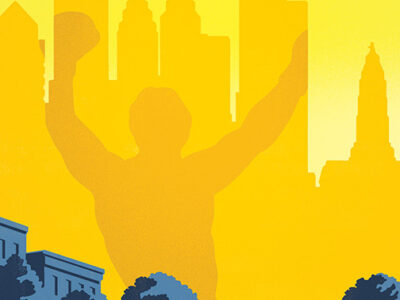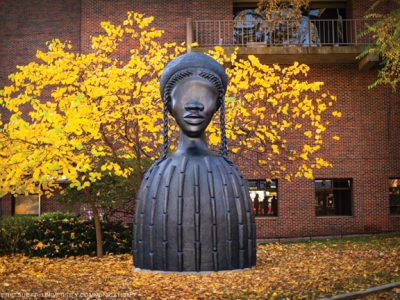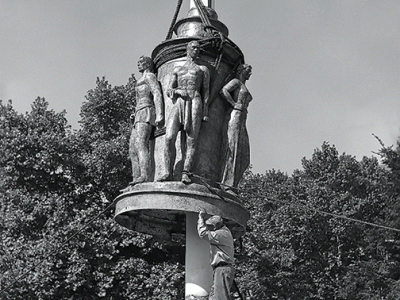
Ever wonder what your neighbors’ daily home lives are like — especially if you live in a community where residents seldom get past each other’s front doors? Gwyneth Leech, C’81, did, and the results of her curiosity are featured in a “video sculpture,” Four Storeys. The piece is part of Scottish Spirit, a 44-work art exhibition that Leech — the first American president of the Society of Scottish Artists — has brought to Penn’s Arthur Ross Gallery this summer.
Four Storeys depicts tenement life in her neighborhood in the West End of Glasgow, a community of Scottish, Indian, Pakistani, and Chinese residents. Leech spent a year working with a group of primary-school children and their families, helping them document on film the parts of their home life that they considered most interesting. Thus the documentary shows such scenes as a family praying during Ramadan, mothers cooking a flat bread called chapati, and children giving extensive house tours. “One little girl cleared out her canary cage for me for 20 minutes,” Leech says. All of the buildings in the neighborhood have four floors — hence the title and the design of the piece, which consists of four video screens stacked inside a black rectangular sculpture covered on each side with knobs, locks, and mail chutes to resemble front doors.
What prompted the project was her travels with her husband, David Wilson, from 1991 to 1993, through Africa and Asia, where they were overwhelmed by the hospitality of strangers. Upon returning, Leech recalls feeling isolated in her West-End Glasgow apartment. “I began to wonder about my neighbors in a new way: ‘How do these people live? What are their families like?’ That’s when I began thinking about this project and that perhaps these people also had the same curiosity about each other.”
The theme of community in Leech’s video sculpture is appropriate for an artist who majored in anthropology at Penn. “What I have found over the years,” explains Leech, “is that the ideas which originally interested me in studying anthropology have persisted and colored the kind of work I do and the subjects I am attracted to as an artist.”
Leech, who comes from a family of artists [and Penn graduates, including her father, Noyes E. Leech, C’43, L’48, an emeritus Law School professor, and her sister, Katharine Leech, C’79], says she first became interested in street markets and urban immigrant communities during her junior year in Paris. That fascination grew into a senior thesis, which led her into the world of Korean shopkeepers and stall-holders in South Philly’s Italian Market.
After graduating from Penn, she attended the Edinburgh College of Art on a Thouron Fellowship, completing her B.F.A. there in 1984. Taking advantage of ample government funding for the arts, she has remained in Scotland, doing printmaking, painting, and video projects — even securing a commission to paint cathedral murals. Leech became a professional member of the Society of Scottish Artists in 1988 and was elected president three years ago.
The SSA was founded in 1891 as an alternative to the Royal Scottish Academy — which at the time excluded women and showed only very specific types of work — to give more space to younger and underrepresented artists.Another of its missions, which continues today, was to inform the Scottish public about alternative and avant-garde art movements and foreign artists. Earlier in this century, for example, it outraged the British press by showing the work of the “subversive” Norwegian painter Edvard Munch.
One artist featured in Scottish Spirit is German native Reinhard Behrens, whose watercolors explore the landscapes of a fictitious Arctic place called Naboland while precisely documenting objects — old spoons, feathers, even a razor — found on walks in the north of Scotland. That’s where the 18th and 19th-century Highland Clearances took place, and hundreds of thousands of residents, many of them tenant farmers, were evacuated from their land to make room for more profitable sheep. “You can go into the glens and find ruins of houses and pick up things like these spoons,” Leech says. Other works in Scottish Spirit, like Leech’s Four Storeys, focus on modern concerns and use non-traditional art forms.
“Partly what we try to do with Scottish Spirit is to show people that the new Scotland is one that’s forward looking instead of just looking back at the Clearances and tartan and heath,” Leech says. “We want to show people that there is an outward-looking arts community, and a number of international artists working in a diverse range of media and ideas.”
Scottish Spirit will be on view at the Arthur Ross Gallery through August 2.




